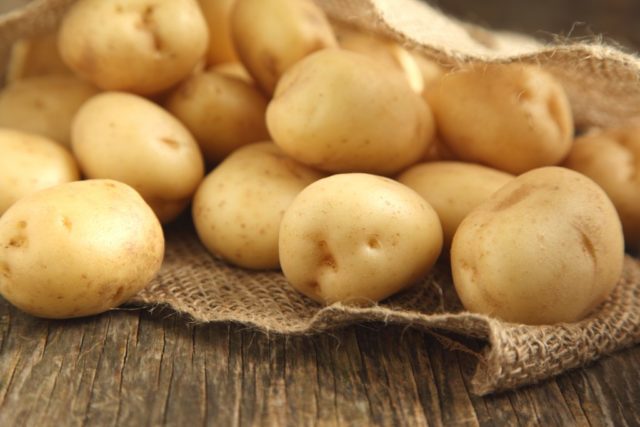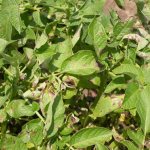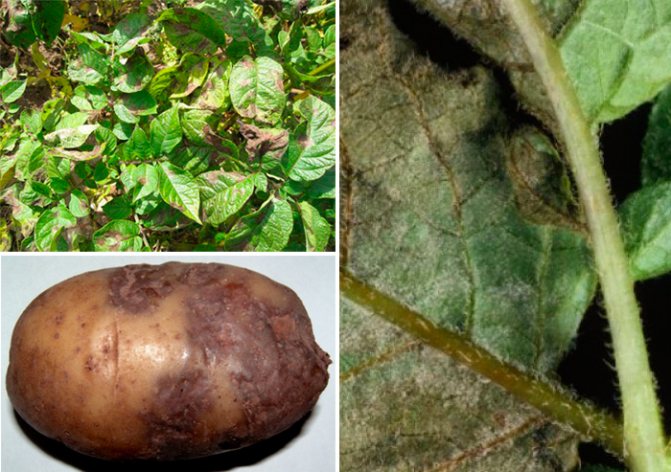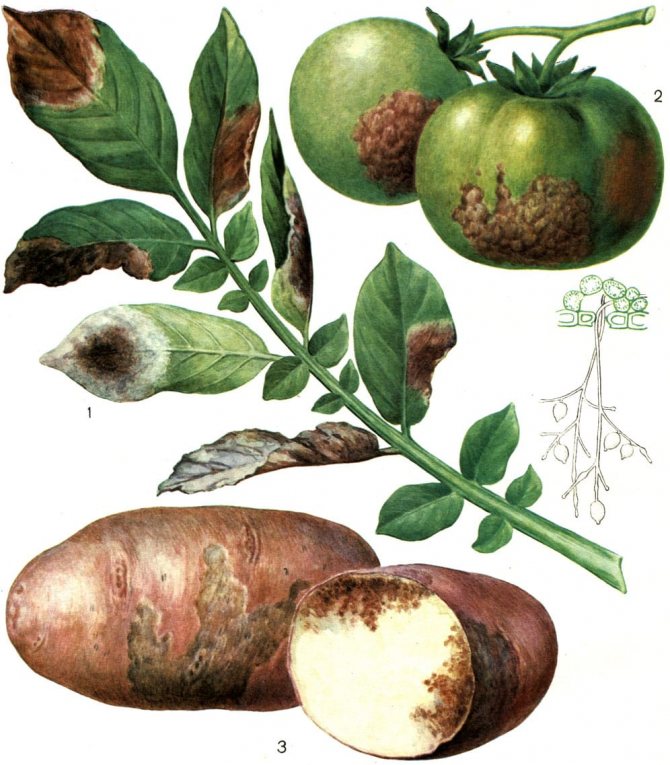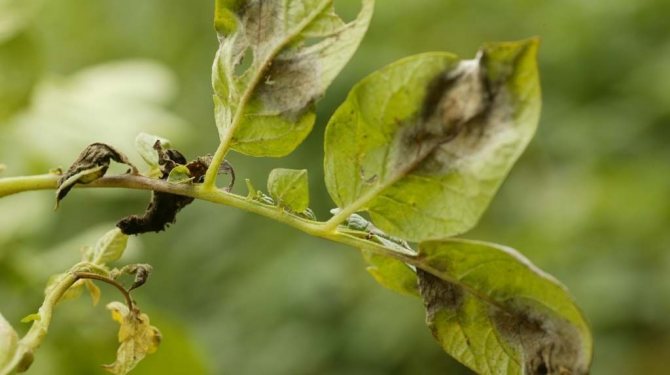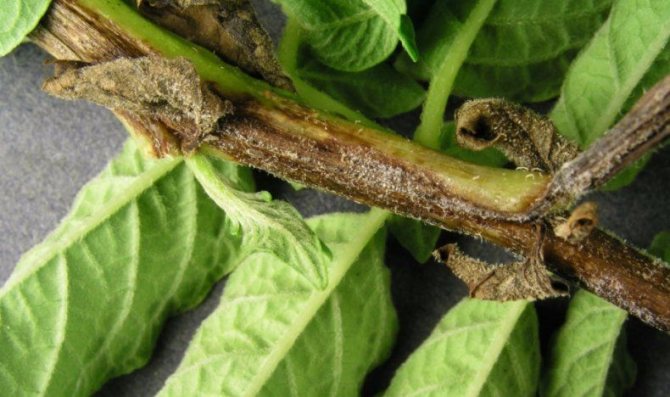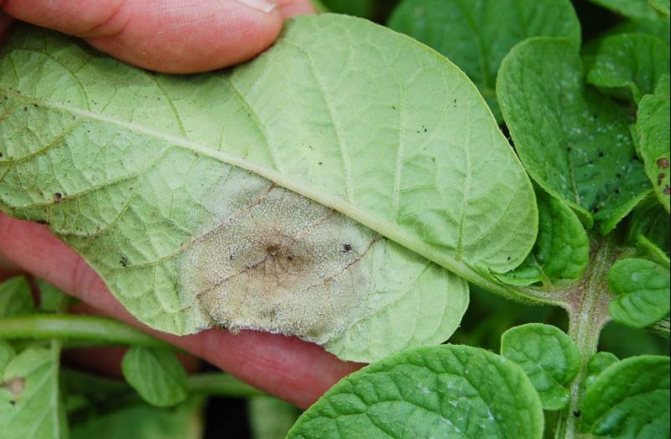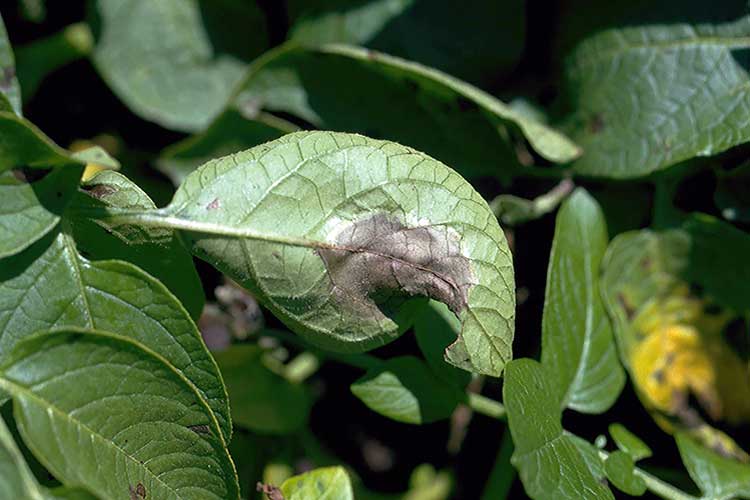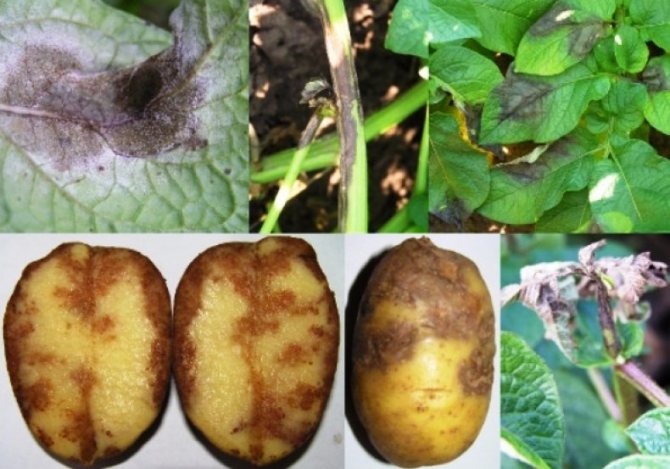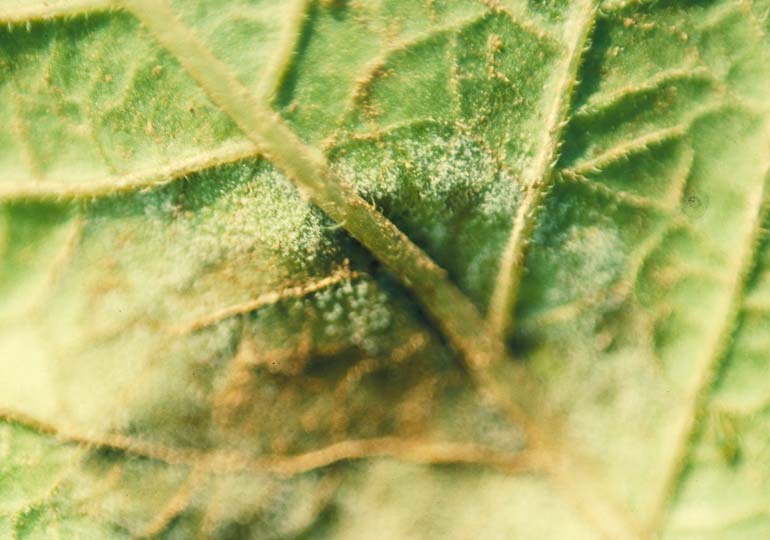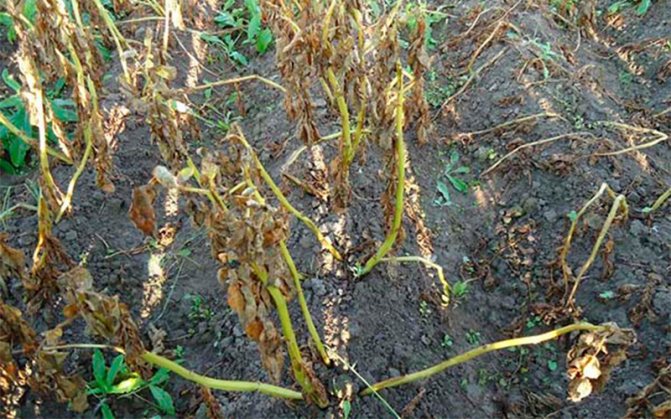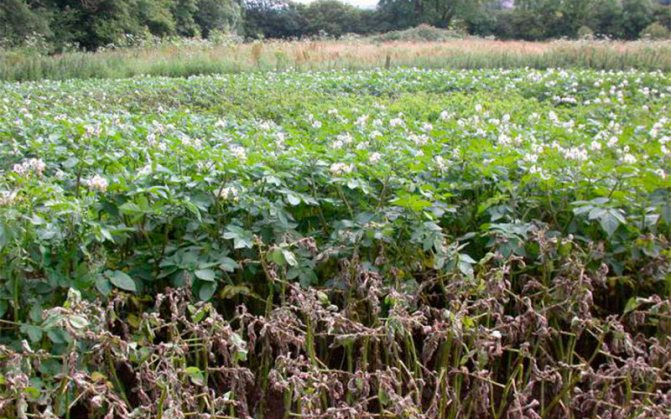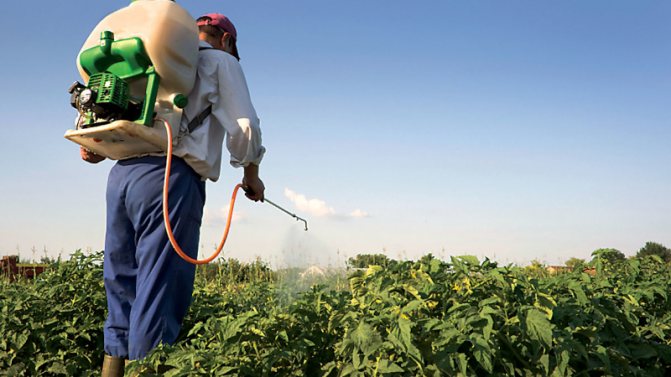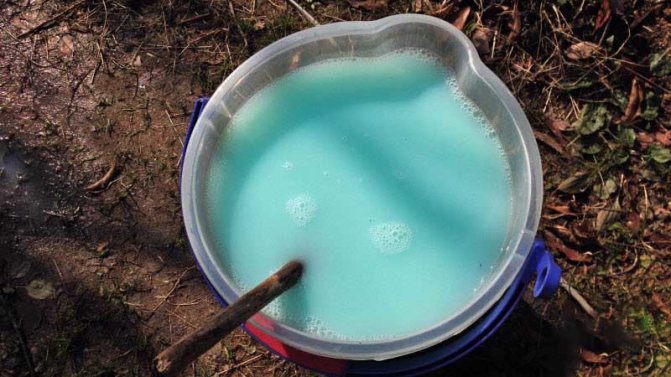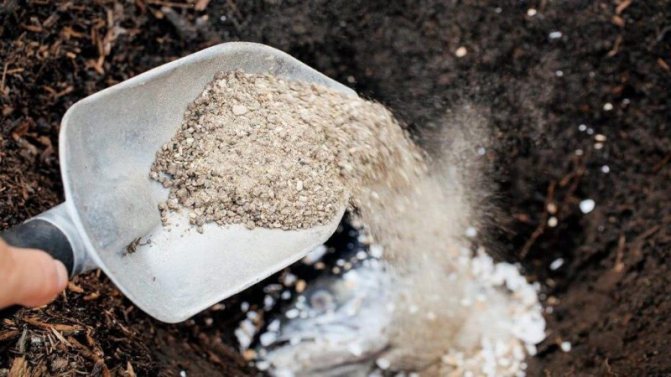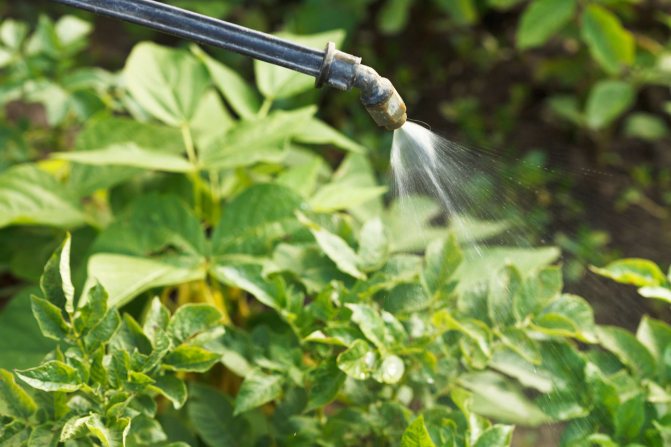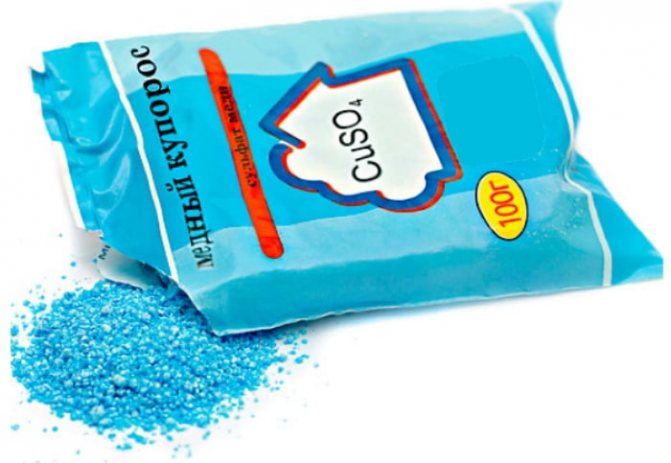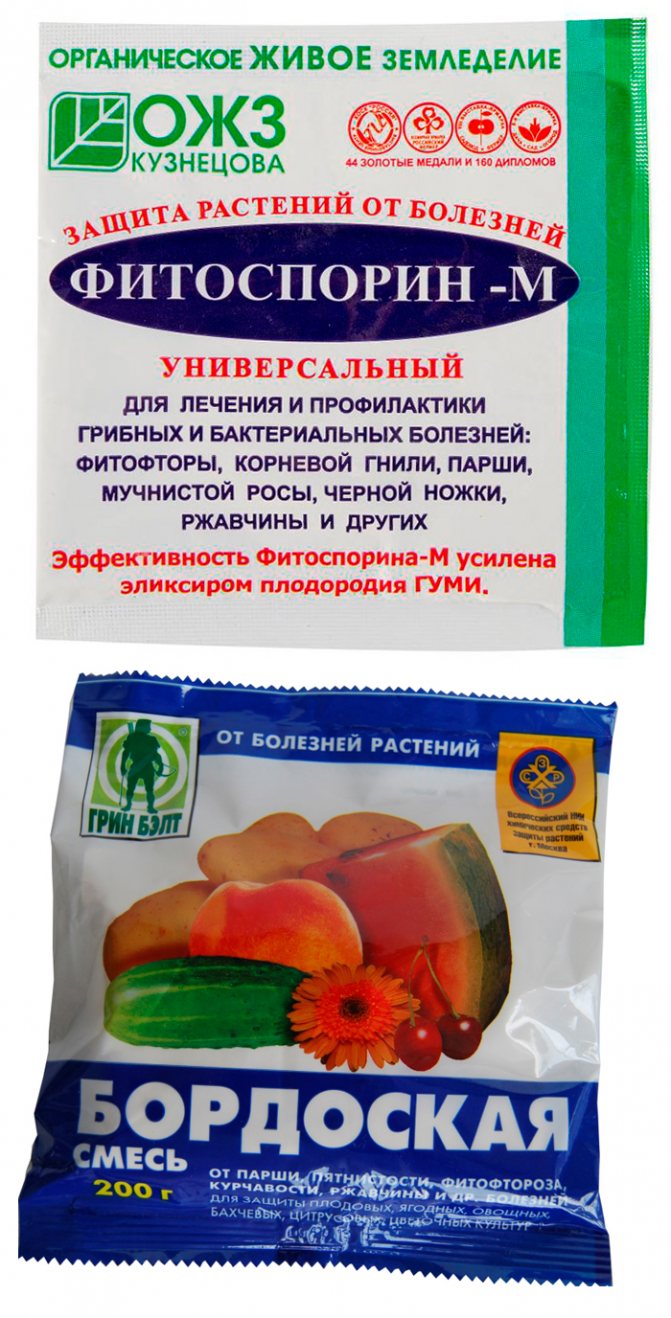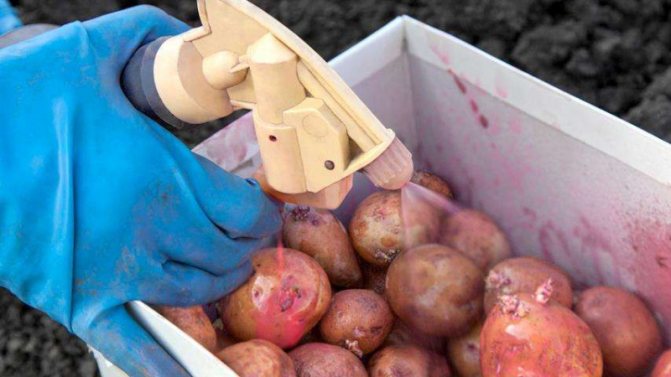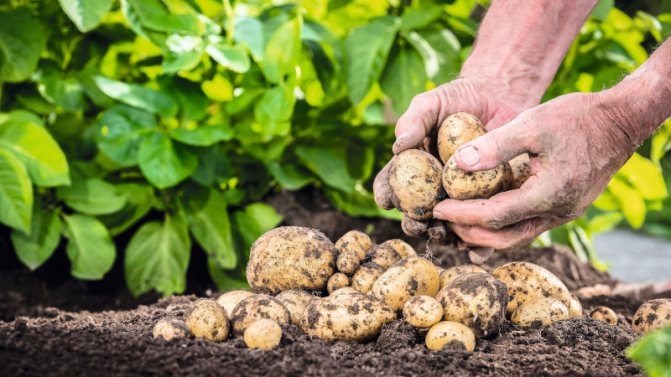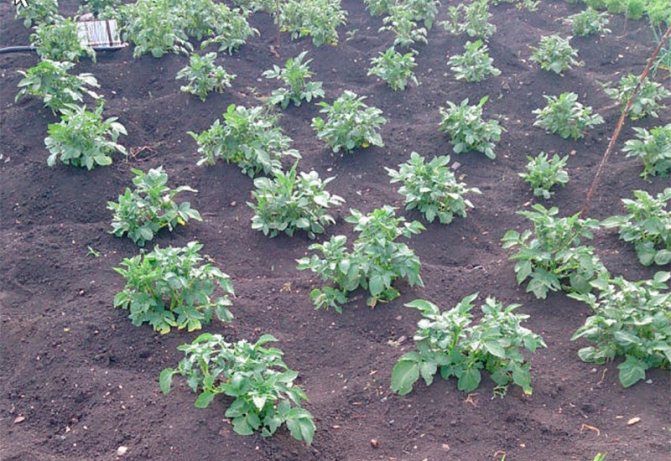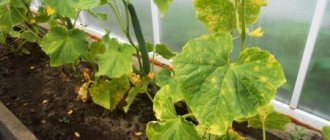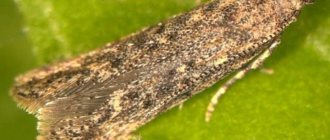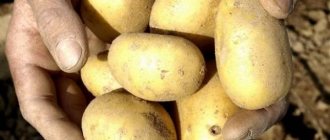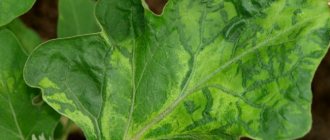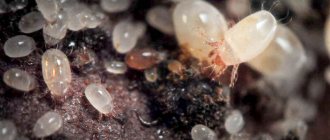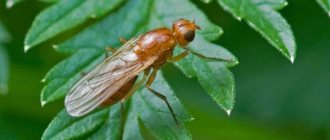Why is late blight of potatoes dangerous?
Late blight disease appears on potatoes in the middle of summer. It is very difficult to get rid of the disease, therefore, when the first signs of the disease appear, it is necessary to remove the damaged bush in a timely manner so that the fungus does not spread to neighboring crops, since late blight destroys up to 70% of the crop.
Why late blight is dangerous for potatoes:
- yield decreases;
- taste and presentation are reduced;
- without treatment, the plant dies;
- late blight reduces immunity, which is why diseases and pests often join potatoes;
- the fungus quickly spreads to neighboring crops.
Important! Since late blight is located on the surface of the root crop, when storing infected potatoes, the fungus can destroy the entire harvested crop.
Infection methods
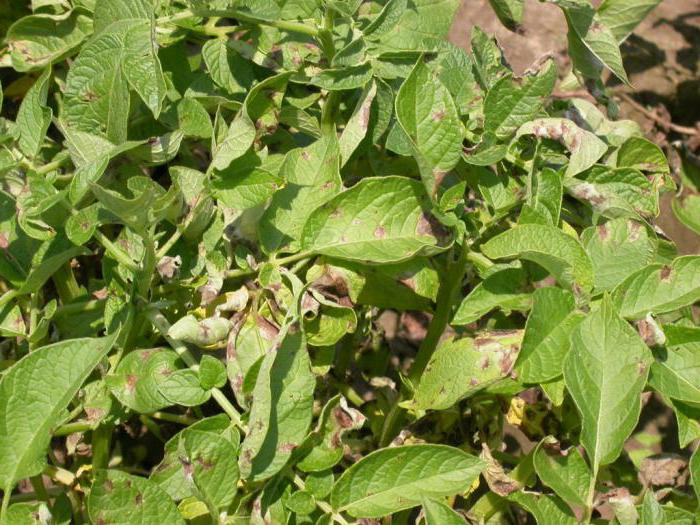
As soon as the germination of the affected tubers occurs, zoosporangia also appear above the soil surface, with the help of which late blight of potatoes spreads. They can rise to the soil surface along soil capillaries together with groundwater. Throughout the season, potato infestation occurs with the help of only zoosporangia. It takes at least four hours in a humid, damp atmosphere for a pathogen to successfully infect a potato bush. Seed material (tubers) most often pick up the disease when it comes into contact with the foliage infected with mycelium.
This can happen either during heavy rain or during autumn harvesting. Oospores can also migrate from diseased tubers to healthy ones, but the proportion of this process is small. There is evidence that Colorado beetles and their larvae can carry mycelium and spores on their bodies. Since in hungry years they also "graze" on tomatoes, they deliver phytophthora to these plants.
Causes of potato late blight
Late blight is a fungal disease that has adapted to adverse climatic conditions. The fungus is not afraid of temperature changes, and it can successfully overwinter on the harvested crop.
Late blight can appear in the middle of summer, if there is a nearby source of infection, then the fungus can attack the entire area. Possible sources:
- infected seed potatoes;
- fungus wintering in the soil or in last year's tops;
- poorly sanitized instruments.
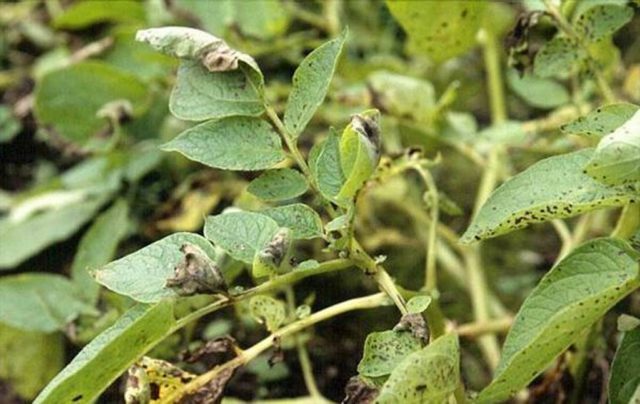

For development, late blight requires favorable conditions:
- air temperature from + 15 to + 25 ° C;
- air humidity above 90%;
- thickened fit;
- evaporation of moisture after irrigation;
- insufficient amount of phosphorus, potassium and copper;
- oversaturation with nitrogen.
When the heat comes, the fungus slows down and dies over time. The affected leaves die off, and new ones grow back, thereby rejuvenating the potato bush.
Important! Late blight often manifests itself during rainy weather and with sudden changes in temperature.
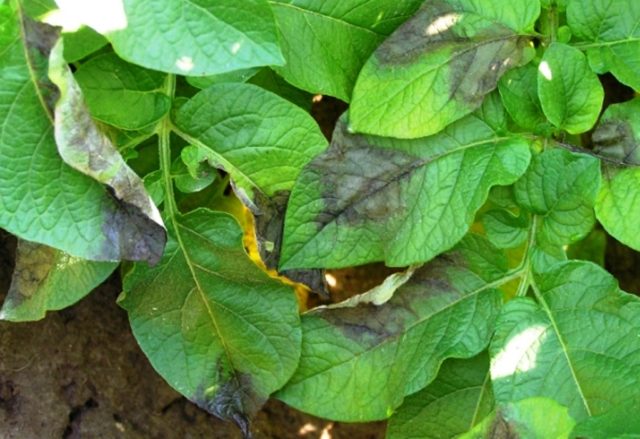

Description of the disease
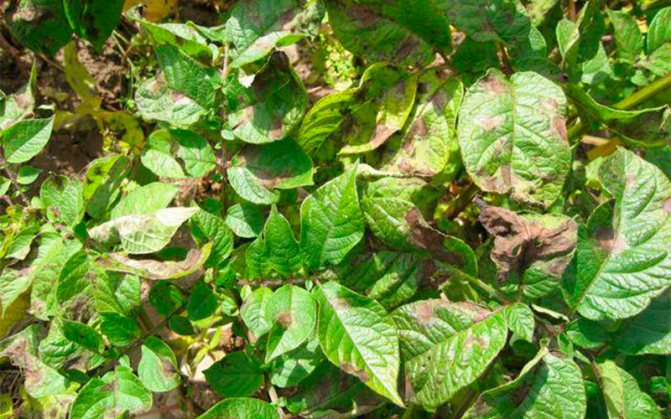

Phytophthora is a fungal disease caused by the oomycete Phytophthora infestans. The class is isolated from the kingdom of fungi, since the structure of the mycelial organisms of the oomycete is slightly different. Reproduction is through zoosporangia, the incubation period is from 3 to 16 days.
Ask and get useful advice from professional gardeners and experienced summer residents. >>
The infection affects tubers, leaves, and plant shoots.Sources of infection:
- seed potatoes;
- tubers left in the soil after harvesting;
- plant residues.
The pathogen is distinguished by its vitality, resistance to subzero temperatures. Risk group - representatives of the nightshade family, among which, in addition to potatoes, sweet peppers, tomatoes, eggplants. Late blight occurs everywhere, with annual losses from fungal infection amounting to 15%.
Signs of late blight on potatoes
To protect potatoes from late blight, you need to know the signs of the disease, since the yield and quality of root crops depend on this.
You can recognize a fungus by its appearance:
- The potato tops acquire a brown-black color. At the initial stage of the disease, the lower part of the green mass is first affected. After 3-5 days, dark spots begin to grow, and a snow-white fungal bloom appears on the inside of the leaf plate. Without treatment, foliage begins to curl and die off.
- The stem is covered with dark oval spots. Over time, they merge, causing cell death and decay. If during the disease the air humidity is lowered, then the stems become lethargic and brittle. Ovaries and flowers change color and fall off over time.
- Potato tubers are affected by late blight at an early stage of the disease. Dense in consistency and vague spots appear under the skin. The pulp becomes brown, softens and begins to rot. Such a root vegetable is not suitable for human consumption and is not suitable for reproduction.
To recognize late blight on potatoes, you need to view the photo:
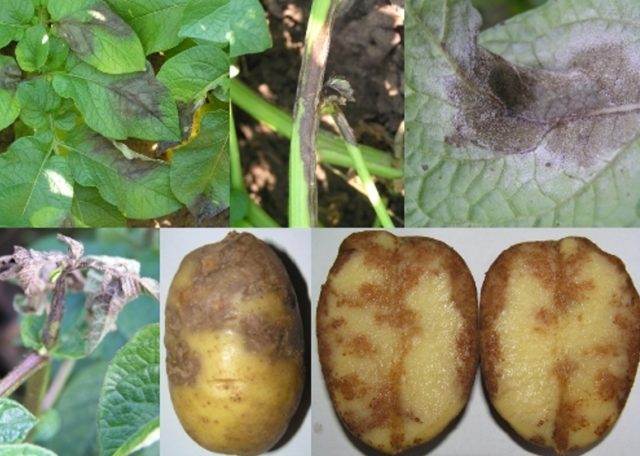

Folk remedies against phytophthora
The use of folk methods of dealing with late blight is permissible if the plants are just beginning to get sick with late blight. Fighting a fungal infection is not easy. In order to save the harvest when Phytophthora infestans is activated, folk remedies are not used.
For preventive purposes, you can apply multiple dusting of potato bushes and row spacings with wood ash. An infusion is made from ash powder: 1 liter of ash is diluted in 2 liters of hot water. Insist 72 hours, filter, spray potato tops after germination, during budding, after flowering. Potato tubers are soaked in the same solution before planting in the holes.
How to deal with late blight on potatoes
To get rid of late blight on potatoes, you must follow the rules of care and, at the first signs of the disease, start timely treatment. To get rid of the fungus, you can use chemicals or fight with folk remedies. Most gardeners prefer folk remedies, since they do not harm the environment, have a positive effect on pollinating insects, and are harmless to the future harvest.
Agrotechnical measures
To prevent and get rid of late blight, you must follow the rules of care:
- Regular loosening and weeding improves air exchange. This makes the skin denser, which prevents spores from entering the pulp.
- In dry and cool weather, irrigation is carried out strictly under the stem, avoiding moisture on the potato tops.
- When the first signs of a disease are detected, the bush is removed from the ground and burned.
- Timely removal of weeds, since a large number of spores accumulate on it, which quickly spread to healthy specimens.
Preparations for late blight on potatoes
Late blight is an incurable disease, but to prevent the disease from spreading and progressing, gardeners use chemicals. Fungicides are effective means to combat potato late blight. But when using them, you need to know that chemicals can accumulate in the soil and roots.Therefore, fungicides for potatoes from late blight are used only in extreme cases, when the disease is neglected, and folk remedies are ineffective.
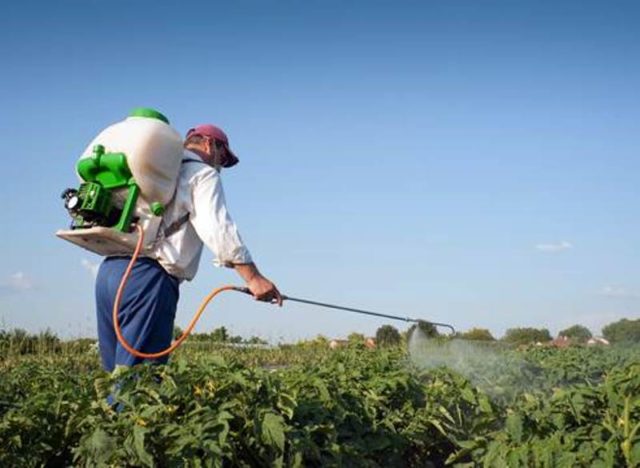

To protect potato plantings from late blight, you must adhere to the following rules:
- Before planting, seed potatoes are treated with Fitosporin.
- Young shoots that have reached a height of 15-20 cm are sprayed with Bordeaux liquid, copper sulfate or copper sulfate.
- If the weather conditions are comfortable for the spread of late blight, then the potatoes are sprayed before flowering with Exiol, Epin, or Oxygumat. If the weather is warm, dry, then you can apply "Krezacin" or "Silkom".
- A month later, re-treatment with broad-spectrum fungicides is carried out. These drugs include "Efal" and "Ditan M-45". If the disease is massive, then it is necessary to apply stronger drugs, such as: "Oxyhom" or "Ridomil". The bush is processed twice with an interval of 10-14 days.
- After flowering, potatoes are sprayed with Bravo.
- A month before the harvest, the final spraying is carried out with the "Alufit" preparation.
Processing is carried out only in dry, calm weather.
Important! In order not to harm the potato bush, fungicides are diluted strictly according to the instructions.
Treatment of late blight of potatoes with folk remedies
To treat potatoes from late blight at the initial stage of the disease, gardeners use folk remedies. They are safe for the environment and will not harm the future harvest. Most often, the following recipes are used to combat late blight:
- Garlic infusion. Chop 100 g of garlic and add to a bucket of warm water. Insist for about 24 hours, then filter the infusion and spray over potato plantings. The procedure is carried out every week for 1 month. Each treatment is carried out with a freshly prepared infusion.
- Kefir infusion. Kefir is poured into a jar and left in a warm room to acidify. The sour fermented milk product is poured into a bucket of water and mixed thoroughly. The container is removed to a warm place for 2-3 hours for infusion. With this infusion, potatoes are processed from the moment of infection to harvest.
- A solution of copper sulfate, boric acid and potassium permanganate. In 3 liters of boiling water, dilute 1 tsp. potassium permanganate, boric acid and copper sulfate. After cooling down, the solution is diluted with 7 L of water. Treatment of potatoes from late blight is carried out in July and August with an interval of 7-14 days.
Important! When the first signs appear, it is necessary to immediately process the potatoes against late blight. If the disease progresses, the potato bush is dug up and burned.
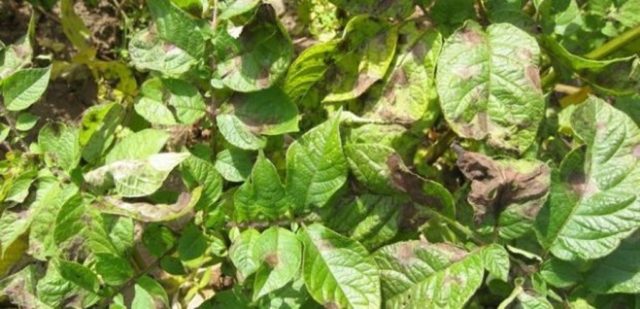

Biologicals
How to get rid of late blight on potatoes without harming the plants? Experienced gardeners use contact biological products for such purposes. Such products contain copper and bacterial cultures. The principle of action of such drugs is to prevent the growth of pathogens before they have time to penetrate the plant tissue.
Copper sulfate and Fitosporin-M are most often used as such drugs.
- Copper sulfate is used in the form of a solution prepared from 10 liters of water and 2 tbsp. tablespoons of dry products. The resulting solution is sprayed with potatoes before flowering. The effectiveness of the treatment depends on how evenly the working fluid was distributed over all surfaces of the above-ground part of the bush.
- Fitosporin-M - this biological product was developed on the basis of spores and living cells of the bacterial culture of Bacillus subtilis, which helps to suppress the activity of the late blight fungus. Fitosporin solution is prepared at the rate of 1 tbsp. spoon of funds in a bucket of water. The resulting working fluid is treated with potato bushes 2 times during a month.
On the basis of the bacteria that make up Fitosporin-M, the biofungicide Antignil has been developed. Both agents have similar properties and are used to treat late blight, fusarium, alternaria, phomosis, scab, and various types of rot.
Prevention of late blight of potatoes
In order not to face difficulties, to collect a generous harvest and to reduce the likelihood of late blight, preventive measures must be followed. These include:
- Processing of potato beds and mulching.
- The choice of quality planting material. Preference should be given to varieties that are resistant to late blight.
- When planting potatoes with weak immunity to this disease, the planting material is kept for 7-10 days in a room with a temperature of + 15-20 ° C. At this temperature, the fungus quickly appears, and if dark spots appear on the seed potatoes, then it is thrown away. To prevent the spread of the disease, the rest of the tubers are treated with the drug "Fitosporin" or "Agate".
- Observe the crop rotation.
- Do not thicken the planting. Closely planted bushes are poorly ventilated, as a result of which a favorable atmosphere is created for the growth of the fungus.
- Hilling potatoes. The higher the earthen mound, the less likely the occurrence of late blight will be.
- When the first signs of the disease appear, the bushes are removed from the garden and burned.
Potato varieties resistant to late blight
To prevent late blight, it is necessary to plant a variety that is immune to the disease. Comparison of potato varieties resistant to late blight shows their resistance to disease and other characteristics.
Dawn. An early variety with white, rounded fruits and few eyes. Root crops have good taste, keeping quality and presentation. Since the shoots germinate quickly, mulching and hilling will help protect the plant from spring frosts. An earthen mound will not only save seedlings from cold weather, but will also help the plant to grow adventitious roots. The variety has a high content of ascorbic acid, so it is very useful for children. Subject to agrotechnical rules, the yield is high, from 1 hundred parts you can collect up to 1500 kg of root crops.
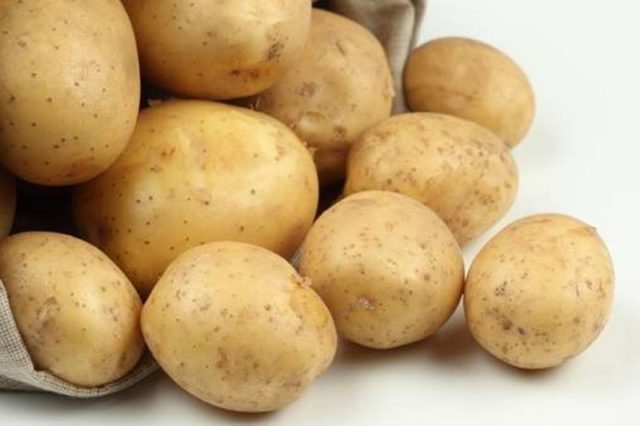

Fast-growing. Table, early ripening variety. Yellowish oval roots weighing up to 128 g have a dense, thin skin. The white pulp contains 17% starch. The variety is high-yielding, with 1 sq. m you can collect up to 3 kg of root crops.
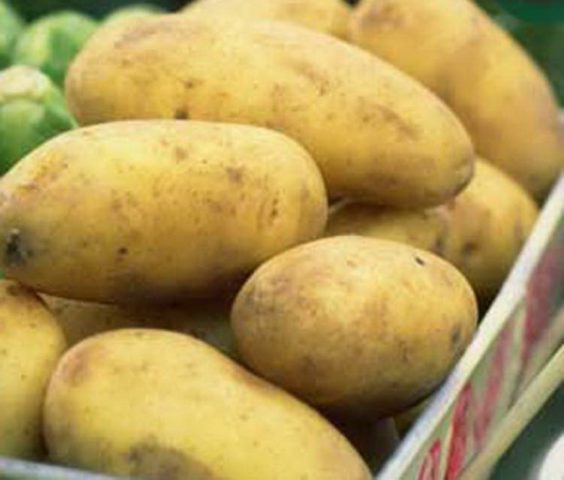

Luck. An early ripe table variety with large yellowish-creamy roots weighing up to 150 g. The variety is high-yielding, up to 10-15 tubers can be removed from the bush. The variety has a number of advantages:
- resistant to sudden changes in temperature conditions;
- fast tying of root crops;
- immunity to fungal diseases;
- good keeping quality and transportability;
- excellent taste.
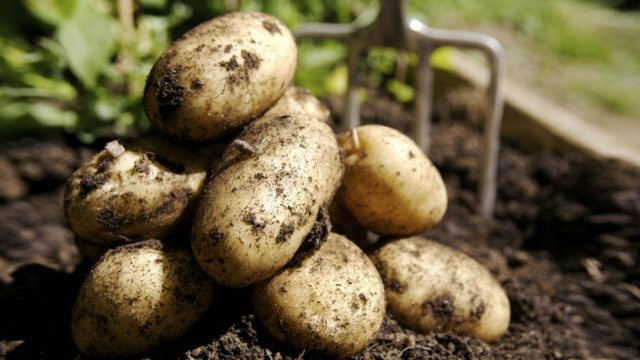

Reserve. Mid-season table variety. White tubers weighing 80-100 g have a smooth skin with few eyes. The variety is high-yielding, with 1 sq. m, subject to agrotechnical rules, you can remove up to 5 kg of root crops. The reserve has good keeping quality and excellent taste. The snow-white pulp is resistant to mechanical damage and contains up to 14% starch.
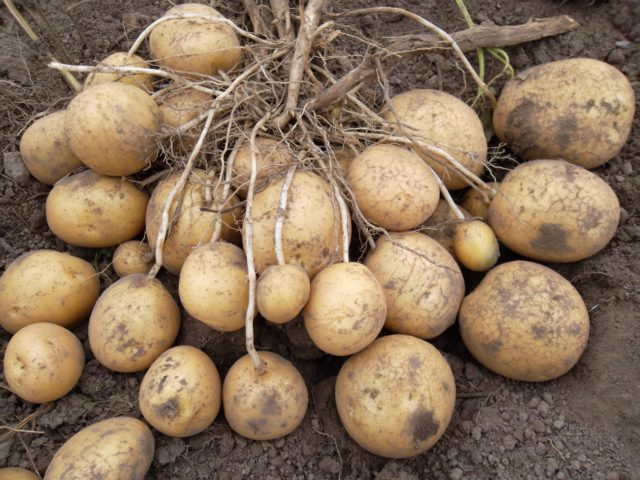

Nevsky. A popular mid-season variety, it takes about 90 days from sowing to harvest. The oblong-rounded roots have a dense whitish-yellow skin. The pulp is pale white, the cut does not darken for a long time. The starch content is about 15%. The variety is high-yielding, up to 15 tubers weighing 130 g can be removed from the bush. The variety is unpretentious, tolerates drought and waterlogged soil well. Potato bushes are disease resistant and rarely attacked by insect pests.
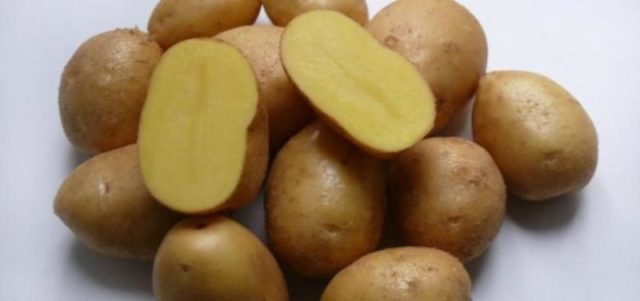

Blue. High-yielding, mid-late variety with tasty, aromatic roots. Potatoes have a number of benefits:
- yield - up to 15 root crops weighing up to 150 g can be removed from the bush;
- unpretentiousness to soil quality;
- drought resistance;
- resistance to sudden changes in temperature conditions;
- the variety rarely suffers from insect pests and fungal diseases;
- marketability - up to 98%;
- good taste and appearance.
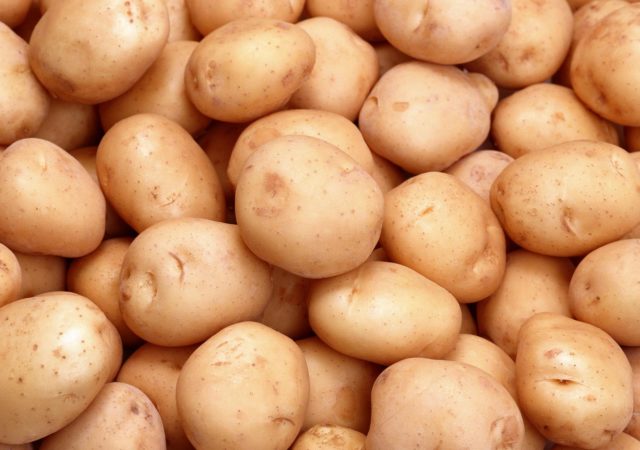

Lugovsky. Medium early variety for table use. From the moment of planting to harvest, it takes about 2.5 months. The tubers are large, weighing 100-150 g, with a smooth, thin pink skin. The variety is high-yielding, has good keeping quality, presentation and taste. The snow-white pulp contains about 15% starch, so the root crop is used for cooking, stewing and making mashed potatoes.
